Solar Info: The Down Low on Everything Up High
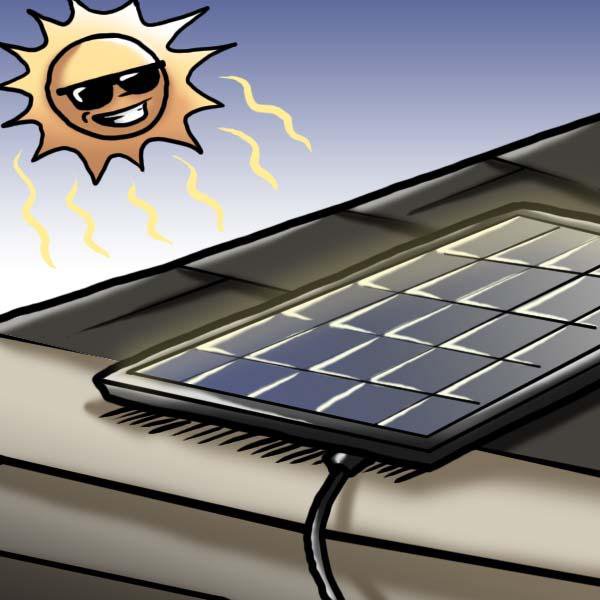
Rain or shine we get a huge number of calls about solar power each day. We’ll attempt to answer the questions asked most often so we can save you a phone call.
Before we get started, you should know that solar power is not the cure-all for replacing spent energy. For example, some people are trying to recharge batteries for a trolling motor, boat, RV, house, electric scooter, backwoods cabin, etc., and they want it done in very short time, usually in just a few days. Assume you take a discharged 100-amp hour battery and charge it with a 30-watt solar panel under ideal summertime light conditions. After a full week, the battery will be just about fully charged. Using this example, you can see that it will take at least 100 watts of solar power to recharge a 100-amp hour battery in a few days.
Also, keep in mind that it takes direct sunshine on the surface of the panel to produce the maximum-rated power of a solar panel. Conditions such as an overcast sky, shadows, improper mounting angle, equatorial direction or short winter days will reduce the actual solar panel output to below the rated values.
VOLTAGE RATING
Most solar chargers are designed for 12 VDC, but we do have limited availability on a 24-volt panel. Typically, when 24 volts or greater is needed, solar panels may be wired in series, or we can special order solar panels that are made to deliver more DC Volts such as 24V, 36V, 48V etc.
CONTROLLERS
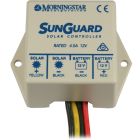 Anytime you use a panel that is over 5 watts rated output, we recommend using a solar charge controller. Actually, a charge controller is a good idea in a majority of applications, as it can provide several benefits such as preventing overcharge, improving charge quality, and preventing battery discharge in low or no-light conditions. Some solar panels are made with blocking diodes pre-installed that prevent battery discharge during low or no-light conditions. In most cases where a 6-watt or larger solar panel is installed, the use of a charger controller is highly recommended. In a nutshell, a solar charge controller acts like an on and off switch, allowing power to pass when the battery needs it and cutting it off when the battery is fully charged. Something to be aware of when selecting a controller is that they are typically rated in amps, while photovoltaic panels are typically rated in watts. That means a solar charge controller such as the Morning Star SS6L, 6-amp controller will work with nearly every panel we sell, right up to about 70 watts.
Anytime you use a panel that is over 5 watts rated output, we recommend using a solar charge controller. Actually, a charge controller is a good idea in a majority of applications, as it can provide several benefits such as preventing overcharge, improving charge quality, and preventing battery discharge in low or no-light conditions. Some solar panels are made with blocking diodes pre-installed that prevent battery discharge during low or no-light conditions. In most cases where a 6-watt or larger solar panel is installed, the use of a charger controller is highly recommended. In a nutshell, a solar charge controller acts like an on and off switch, allowing power to pass when the battery needs it and cutting it off when the battery is fully charged. Something to be aware of when selecting a controller is that they are typically rated in amps, while photovoltaic panels are typically rated in watts. That means a solar charge controller such as the Morning Star SS6L, 6-amp controller will work with nearly every panel we sell, right up to about 70 watts.
POWER RATING WATTS AND AMPS
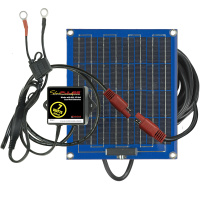 Solar panel manufacturers rate solar output in watts. As a rule of thumb, a rating of 15 watts delivers about 3,600 coulombs (1 AH) per hour of direct sunlight. As an example, the Pulse Tech SP-7 panel can output .33AH per hour of direct sunlight. This is a very popular panel for maintaining single and dual batteries for stand-by and storage applications.
Solar panel manufacturers rate solar output in watts. As a rule of thumb, a rating of 15 watts delivers about 3,600 coulombs (1 AH) per hour of direct sunlight. As an example, the Pulse Tech SP-7 panel can output .33AH per hour of direct sunlight. This is a very popular panel for maintaining single and dual batteries for stand-by and storage applications.
HOW DO I FIGURE SOLAR PANEL SIZE
The first thing to remember about solar power is that it is all a matter of numbers. The power you require vs. the power the panel can put out. Before you can even get started when purchasing a panel, you need to know how many amp hours or watts you’ll need to produce in a set period of time. This figure could be measured in hours or days. Since there are 24 hours in a day, we suggest you use that as a baseline. First, determine your total electrical consumption in that time period. Then figure the amount of direct sunlight the solar panel will receive in that time period and come up with a total amount of watt hours needed. You should always err on the side of caution and over-estimate your power needs. Typically we see an average of 4 hours of usable sunlight in the winter, and 6 hours of usable sunlight in summer. Granted, there are exceptions to these averages, but erring on the side of caution creates a more reliable solar system. These averages also help compensate for variables like shade, clouds, panel angle, etc. Once you have a good handle on your power requirements, I suggest you go to our Solar Calculator.
OUTPUT CONDITIONS
Solar panel ratings are calculated in bright direct sunlight. Conditions such as indirect sunlight, overcast and partial shade conditions will decrease the output. We always recommend over-sizing the size of your solar array, as these conditions occur often. Also, remember that the length of daylight in summer vs. winter can make an impact.
One of the biggest errors commonly seen is when a solar array is designed in summer using summer daylight hours, but then it’s also used in the winter. The first complaint is often related to the batteries no longer holding up under load. This is a gradual process that begins when you lose daylight hours, and you start taking the battery pack beyond a 50% depth of discharge. When this happens, the batteries start to sulfate at a much quicker rate, and begin to no longer hold under load. As you can imagine, this is an expensive mistake! The solution generally involves more panels and new batteries with a higher Amp/Hr reserve. Therefore, we advise our customers to be conservative when accounting for daylight hours. Also, if you plan to utilize a solar array year-round, then you need to factor in your daily solar input for winter.
OPERATING A DEVICE DIRECTLY FROM A SOLAR PANEL BATTERY CHARGER
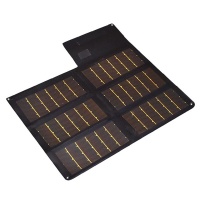 We carry several foldable/portable solar panels for backpacking that come with a female cigarette lighter adapter. This adapter allows you to power 12v accessories that commonly use a 12v DC plug. In order to connect directly to a panel, the device cannot be sensitive to voltage variation—otherwise they may shut down. To solve this problem, it’s best to use a small battery as a storage vessel for energy that will provide constant source of stable, reliable power. To do this, we recommend using a solar charge controller, Y-connector with a battery inline on one leg, and the female cigarette socket on the other leg.
We carry several foldable/portable solar panels for backpacking that come with a female cigarette lighter adapter. This adapter allows you to power 12v accessories that commonly use a 12v DC plug. In order to connect directly to a panel, the device cannot be sensitive to voltage variation—otherwise they may shut down. To solve this problem, it’s best to use a small battery as a storage vessel for energy that will provide constant source of stable, reliable power. To do this, we recommend using a solar charge controller, Y-connector with a battery inline on one leg, and the female cigarette socket on the other leg.
ARE SOLAR PANELS WEATHER PROOF
Nearly all solar panels are designed for outdoor installation, as this is where they will receive the best, most direct exposure to sunlight. Remember that anything less than that will cause the panel to produce less than its full-rated power.
DO I HAVE TO MAINTAIN SOLAR PANELS
A periodic inspection to remove dirt, debris and check electrical connections is all that is needed. Keeping the panel clear of snow and debris will allow for better results.
HOW LONG DO SOLAR PANELS LAST
Performance from a solar panel will vary, but in most cases guaranteed power output life expectancy is between 3 and 25 years. This guaranteed life expectancy rating is usually 80% of the published rating of the solar panel. Of course, this will vary from manufacturer to manufacturer, and as always, you typically get what you pay for. Watch out for those cheap panels made in Paki-china-nam-istan.
USE OF A POWER INVERTER
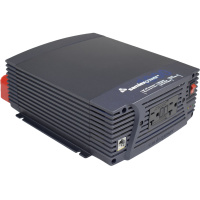 Many folks use a DC to AC power inverter to convert 12 VDC to 110 VAC. Since they change power from one form to another, inverters are power-gobbling monsters and should be avoided when possible. If you have a choice of a 12-volt, DC-powered device or 110-volt AC device, go with the 12-volt DC device. There are DC devices on the market that either step down or step up DC power, and these also use significantly more power.
Many folks use a DC to AC power inverter to convert 12 VDC to 110 VAC. Since they change power from one form to another, inverters are power-gobbling monsters and should be avoided when possible. If you have a choice of a 12-volt, DC-powered device or 110-volt AC device, go with the 12-volt DC device. There are DC devices on the market that either step down or step up DC power, and these also use significantly more power.
DC to AC via an Inverter Formula Examples
This “rule of thumb” is intended as a general guide for estimating the DC amps required operating a DC to AC power inverter. Since the calculations yield approximate values, an appropriate safety factor should be considered when designing and specifying system components, such as wire, size and length. This basically means “oversize your system.”
12-Volt DC Systems
Formula: 12-volt inverters require approximately ten 10 amps DC input for each 100 watts output power used to operate an AC load.
Example: How many DC amps will a 12-volt inverter require to operate three 500-watt quartz lights, or a 1500-watt electric heater?
Answer:
- 1) Total watts = 1500
- 2) 1500 watts/100 (from formula) = 15
- 3) 15 X 10 amps (from formula) = 150 amps.
This is the DC current the inverter will use to operate the 1500-watt load. Note: If these 150 amps are drawn from the battery for one hour, 150 amp hours of battery power will be used.
To support 150 amp hours of battery power, 300 amps of battery capacity should be used for maximum battery life and performance.
24-Volt DC Systems
Formula: 24-volt inverters require approximately 5 amps DC input for each 100 watts output power used to operate an AC load.
Example: How many DC amps will a 24-volt inverter require to operate three 500-watt quartz lights, or a 1500-watt electric heater?
Answer:
- 1) Total watts = 1500
- 2) 1500 watts/100 (from formula) = 15
- 3) 15 X 5 amps (from formula) = 75 amps.
This is the DC current the inverter will use to operate the 1500-watt load. Note: If these 75 amps are drawn from the battery for one hour, 75 amp hours of battery power will be used.
To support 75 amp hours of battery power, 150 amps of battery capacity should be used for maximum battery life and performance.
Ready to harness the power of the sun? Shop for a solar charger and accessories.
Whether you need a solar battery charger for boat, solar trickle charger for car battery, or a solar ac charger, we have the right chargers for any application.
• Rated article 5 • August 2, 2024 at 7:19 am
• September 27, 2024 at 11:39 am
• Rated article 5 • May 29, 2024 at 2:14 pm
• May 30, 2024 at 7:31 am
• Rated article 5 • April 3, 2023 at 3:06 pm
• Rated article 5 • April 28, 2023 at 9:30 am
• Rated article 5 • August 22, 2022 at 6:16 pm
• Rated article 5 • August 23, 2022 at 12:34 pm
• Rated article 5 • July 4, 2022 at 4:37 pm
• Rated article 5 • July 14, 2022 at 9:39 am
• Rated article 5 • October 9, 2021 at 10:51 am
• Rated article 5 • November 1, 2021 at 9:26 am
• Rated article 5 • June 19, 2020 at 1:09 pm
• Rated article 5 • June 19, 2020 at 1:17 pm
• Rated article 5 • May 25, 2020 at 6:12 pm
• Rated article 5 • June 15, 2020 at 12:08 pm
• Rated article 5 • May 16, 2020 at 2:11 pm
• Rated article 5 • May 18, 2020 at 1:17 pm
• Rated article 5 • May 9, 2020 at 6:15 am
• Rated article 5 • May 11, 2020 at 10:08 am
• Rated article 5 • April 20, 2020 at 9:44 am
• Rated article 5 • April 20, 2020 at 9:55 am
• Rated article 5 • March 13, 2020 at 8:49 am
• Rated article 5 • March 20, 2020 at 3:05 pm
• Rated article 5 • November 30, 2018 at 8:23 am
• Rated article 5 • November 30, 2018 at 8:51 am
Please confirm.
• June 28, 2016 at 4:59 am
• January 19, 2017 at 9:10 am
• Rated article 5 • June 20, 2016 at 10:38 am
• January 17, 2017 at 12:21 pm
• June 16, 2016 at 1:34 am
• January 17, 2017 at 11:31 am
• June 11, 2016 at 2:20 pm
• January 17, 2017 at 10:15 am
• June 7, 2016 at 3:11 pm
• Rated article 5 • June 9, 2016 at 11:47 am
I’ve got a question: my charge controller just died on me and it will be about two weeks before I can get a new one. I’m very off grid and depend on my battery power.
Can I hook up my 100w solar panel to the battery directly for a couple of hours to get some juice in without a charge controller? battery directly for a couple of hours to get ssome
• June 7, 2016 at 10:44 am
• Rated article 5 • June 9, 2016 at 11:40 am
battery one & three negative Battery 3 has 1 positive and 1 negative (links to bat 2) I can forward over pictures of battery bank and the wiring diagram. Any help would be greatly appreciated. I hope to hear from you!
• June 4, 2016 at 1:05 pm
• Rated article 5 • June 9, 2016 at 11:16 am
• Rated article 5 • June 1, 2016 at 2:55 am
• Rated article 5 • June 3, 2016 at 2:30 pm
• May 29, 2016 at 5:22 pm
• Rated article 5 • June 3, 2016 at 2:11 pm
1. 1500w 12v inverter
2. 200AH battery (1 unit)
3. 300w solar panel(1unit)
4. Sunshine hour =8hr
These my questions
1. Can this system provide 1500watt-hour during the day and another 1500watt-hour during the night
2. How long would it take the solar panel to fully charge the battery
3. Is the inverter strong enough to run a water pumb of 1HP.
Thanks
• May 21, 2016 at 4:33 am
• May 26, 2016 at 7:27 am
• Rated article 4 • May 11, 2016 at 9:03 pm
• Rated article 5 • May 19, 2016 at 11:45 am
• May 11, 2016 at 8:47 pm
• Rated article 5 • May 12, 2016 at 10:20 am
• May 5, 2016 at 3:40 pm
• May 6, 2016 at 7:24 am
• April 22, 2016 at 8:42 pm
• Rated article 5 • April 25, 2016 at 9:18 am
• Rated article 4 • April 13, 2016 at 9:51 pm
• Rated article 5 • April 14, 2016 at 9:19 am
• November 29, 2014 at 4:24 am
• December 30, 2014 at 9:19 am
• November 12, 2014 at 8:42 pm
• November 4, 2014 at 10:26 am
• Rated article 5 • November 19, 2014 at 10:51 am
• September 15, 2014 at 12:43 pm
• September 25, 2014 at 11:15 am
• September 8, 2014 at 3:03 pm
• September 25, 2014 at 10:07 am
• August 22, 2014 at 9:44 am
• August 21, 2014 at 1:20 am
• August 12, 2014 at 12:11 am
• August 15, 2014 at 2:30 pm
• Rated article 1 • August 10, 2014 at 2:48 am
• August 15, 2014 at 2:29 pm
• Rated article 1 • July 28, 2014 at 1:28 am
• July 15, 2014 at 5:05 pm
• August 15, 2014 at 2:29 pm
can you tell me the minimum possible size of a 3v solar panel?? We would require more information about your situation. Please contact one of our techs at tech@batterystuff.com.
• July 13, 2014 at 12:44 am
• Rated article 5 • July 11, 2014 at 8:34 am
• Rated article 5 • July 11, 2014 at 8:33 am
• June 27, 2014 at 8:59 am
• June 25, 2014 at 1:11 pm
I would like to power a single LED, ideally 24/7. I am trying to come up with an arrangement that would let me do this. 3.3V LED (max 3.6V) with 20mA draw, typical Li-ion rechargeable battery looks to be 3.7V, and I can get solar panels that are 1V, 2V, 4.5V, 6V, 12V etc… Any advice? Will this work?
• June 18, 2014 at 10:08 am
• June 20, 2014 at 12:02 pm
• June 18, 2014 at 2:12 am
• June 9, 2014 at 4:16 pm
• June 16, 2014 at 10:55 am
• June 7, 2014 at 5:48 am
• June 16, 2014 at 10:29 am
• June 6, 2014 at 8:47 am
• June 5, 2014 at 2:54 pm
• May 26, 2014 at 1:32 pm
• May 27, 2014 at 9:47 am
• Rated article 5 • May 5, 2014 at 1:57 am
• May 3, 2014 at 6:59 am
• Rated article 5 • April 30, 2014 at 8:13 am
I live in Iraq and we have sun all year around. Thanks
• April 28, 2014 at 5:55 am
• Rated article 5 • April 7, 2014 at 8:33 pm
• April 1, 2014 at 10:29 am
Maximum Power 90w
Open Circuit current 59.8v
Short Circuit Current 2.62A
Voltage at point of Maximum 45.4v
current at point of maximum 1.99A
Maximum System Voltage 600V
Maximum Series Fuse 5A. My Questions
1. How efficiently can the solar module be used?
2. Can it work with 650watt inverter with 2 Heavy duty battery? That’s what is common over here.
Keep the good work going.
• March 23, 2014 at 5:19 am
• February 8, 2014 at 12:19 pm
• Rated article 5 • February 10, 2014 at 8:40 am
• Rated article 5 • September 26, 2013 at 12:26 pm
We were told that solar panels do not work with these kind of batteries? Any truth? It does seem like we are fighting our system more and more! It is a mixed system with gels and deep cycles, but it sounds like i should pull out the gels and make them one separate bank that I charge from the generator and keep the deep cycles charged from the panels. Any suggestions are appreciated-
• March 7, 2013 at 5:38 am
• March 7, 2013 at 8:48 am
• March 4, 2013 at 7:46 pm
• March 5, 2013 at 9:18 am
• January 31, 2013 at 11:15 am
• January 31, 2013 at 11:34 am
• December 25, 2012 at 9:48 am
• December 3, 2012 at 7:02 pm
• December 4, 2012 at 8:04 am
• November 12, 2012 at 7:25 am
• November 12, 2012 at 8:23 am
• November 13, 2012 at 12:03 am
• November 13, 2012 at 9:07 am
• October 10, 2012 at 12:07 am
• October 10, 2012 at 9:50 am
• October 7, 2012 at 7:59 am
• October 8, 2012 at 8:42 am
Now most people for whom I install also have a water pump that they run with the help of a generator, some of them have 12v output, some gennies Do Not!
To augment the charging process (esp in days of no sun) all clients would like to be able to use their gennie aswell as the regular solar setup!
What system (charger) do you recommend? Options? Is there a DC/AC input charger or is manual switching necessary ????
Not quite sure what is needed?
Thanks.
• August 26, 2012 at 1:20 pm
• August 27, 2012 at 10:34 am
• August 19, 2012 at 1:32 am
• August 20, 2012 at 11:29 am
• August 18, 2012 at 1:52 am
• August 20, 2012 at 11:22 am
• August 21, 2012 at 4:34 am
• August 21, 2012 at 8:09 am
I need about 20 amps for 8 hours a day 220volts A/C.load 1200btu a/c and 2 lights 1 television Can you send a line drawing for this system the battery and inverter needed and the size or awg of the wire. I live in a tropical island and have limited resources on solar equipment so if you can send a link to buy the items needed
• July 13, 2012 at 1:09 pm
• July 13, 2012 at 4:31 pm
My Kyocera panel puts out 18.8 volts max.
Can I use a 12v switch for this, or would a 24 volt switch be appropriate?
• June 28, 2012 at 7:20 pm
• June 29, 2012 at 8:35 am
• Rated article 5 • June 6, 2012 at 3:47 pm
• June 6, 2012 at 4:26 pm
I have 210 watts of mixed 12v solar panels (1×130w, 1×60w, 1×20w) running into an MPPT charge controller, 2 6v 232ah deep cycle batteries from Interstate hooked together to make 12v
232ah.
The 232ah is sufficient to run what I need daily but I'd like more. The mppt charge controller show on screen that in full sun during the Bulk stage I can get upto 9amps total and something like 130 watts going into the battery bank. The problem is when the battery gets to around 12.6-8 Volts the Charge controller switches to Float mode and only charges the batteries 1-3 amps. At that point i‘m loosing watts. Do I need a bigger battery bank so that it doesn‘t go into float as fast? I never get a charge more then 13.4 volts because of this float mode. • June 3, 2012 at 12:27 am
• June 5, 2012 at 11:27 am
• May 21, 2012 at 10:57 pm
• May 22, 2012 at 10:47 am
• May 19, 2012 at 9:12 pm
• May 22, 2012 at 10:14 am
• Rated article 5 • May 19, 2016 at 6:06 am
• Rated article 5 • May 19, 2016 at 1:17 pm
• Rated article 3 • May 10, 2012 at 8:06 am
• May 10, 2012 at 9:10 am
• May 8, 2012 at 2:02 pm
• May 8, 2012 at 2:19 pm
• May 3, 2012 at 12:55 am
• May 3, 2012 at 8:29 am
I‘d like to run 16W of LED lights from a smallish battery that will be charged by a solar panel. What size panel and what size battery would be suitable to give me 3hrs of light per day for 3 days without charging the battery. In addition how long will it take the panel you suggest to charge the battery you suggest.
Thanks very much. (My basic calc. suggests a 20W panel and a 35 Ahr battery? assuming the battery shouldn‘t discharge more than 50%)
• April 22, 2012 at 12:32 pm
• April 23, 2012 at 9:23 am
• Rated article 5 • April 21, 2012 at 10:28 am
• April 23, 2012 at 9:03 am
• Rated article 5 • April 20, 2012 at 3:05 pm
• April 12, 2012 at 9:21 pm
• April 13, 2012 at 9:01 am
• Rated article 5 • April 12, 2012 at 11:16 am
• April 12, 2012 at 11:28 am
• June 23, 2014 at 2:20 pm
• June 25, 2014 at 9:08 am
• April 11, 2012 at 11:05 pm
• May 4, 2012 at 5:53 pm
• April 12, 2012 at 9:10 am
• April 8, 2012 at 7:03 pm
• April 9, 2012 at 9:40 am
• March 23, 2012 at 8:57 am
• March 9, 2012 at 6:16 pm
• March 12, 2012 at 9:08 am
changing our automatic gate opener batt each year. the tech said that the solor panel was not getting enough sun so he moved it about 40/50 feet. does the resistance in the wire reduce the effectivness of the ammount of emf that is being conducted by the solor panel to the batt.?
steve loxahatchee, Florida
• Rated article 2 • February 16, 2012 at 9:15 am
• Rated article 5 • February 16, 2012 at 2:03 pm


